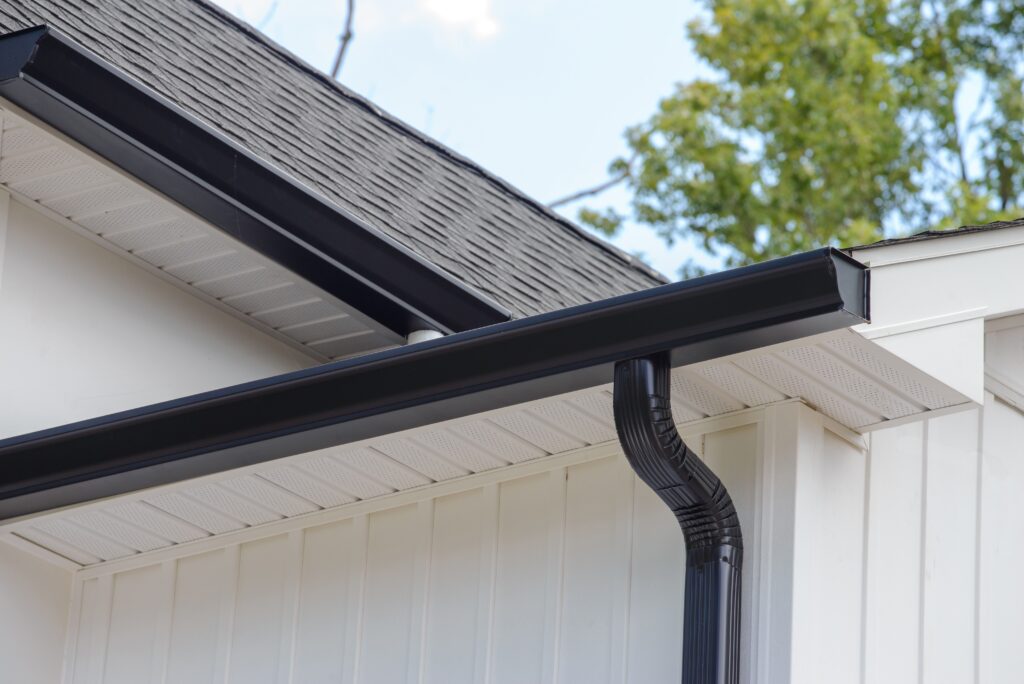Types of Gutters for Your Home

Choosing the right gutters is one of the most important decisions for protecting your home from water damage. As the first line of defense against rainwater, gutters channel water away from your roof, walls, and foundation, helping to prevent costly problems like erosion, basement flooding, and structural cracks.
Understanding the different types of gutters can help you make an informed choice that not only protects your home but also complements its style and fits your budget.
Table of Contents
Why Gutters Are Important for Your Home
Well-maintained gutters play a critical role in preserving both the structural integrity and appearance of your home. By effectively managing rainwater, they prevent a host of costly problems that could compromise your home’s safety.
Preventing Water Damage
Rainwater, if left unmanaged, can cause significant damage to a home. Without gutters, water tends to pool around the foundation, creating pressure that can lead to cracks, leaks, and, in extreme cases, structural failure. Over time, unchecked water infiltration can also result in mold growth, wood rot, and the deterioration of roofing materials, leading to expensive repairs.
- Roof Protection: Gutters prevent water from collecting on the roof, where it could seep into shingles or cause ice dams in colder climates.
- Foundation Safety: By channeling water away from the base of your home, gutters reduce the risk of erosion and cracks in the foundation.
- Wall Safeguarding: Without proper drainage, rainwater splashes against walls, leading to staining, mildew, and damage to exterior finishes.
Maintaining Landscaping
Your yard is another area where gutters play a vital role. Rainwater runoff can erode topsoil, destroy plants, and damage flower beds.
- Soil Retention: Gutters keep soil in place by directing water toward safe drainage areas.
- Plant Protection: They prevent water from pooling around roots, which can drown plants or lead to root rot.
Extending Home Longevity
Gutters reduce wear and tear on your home’s exterior.
- Siding Protection: Water stains, mildew, and peeling paint are minimized when gutters are functioning properly.
- Reduced Maintenance: With less water damage, homeowners can avoid frequent repairs and repainting.
How can I tell when my gutters need to be replaced?
Gutters typically give clear signs when they are nearing the end of their lifespan or need replacing:
- Visible Cracks or Holes: Even small cracks can allow water to seep through and damage your home’s foundation or siding.
- Rust or Corrosion: Rust, especially on steel gutters, indicates the protective coating is compromised.
- Sagging or Pulling Away: If gutters sag or detach from the house, it could mean they are too heavy due to debris or water, or that the fasteners have failed.
- Peeling Paint or Water Stains: Water overflow from malfunctioning gutters can damage paint and cause watermarks on siding.
- Pooling Water Around the Foundation: Improperly functioning gutters fail to divert water away, leading to foundation issues.
Regular inspection and maintenance can prolong the life of your gutters, but if these issues persist, replacement is likely necessary.
Common Types of Gutters
Each type of gutter is designed to meet different functional, structural, and aesthetic needs. Here’s a closer look at the most popular styles, along with their advantages and limitations. With a clear understanding of each gutter material’s characteristics, you can choose the one that best fits your home’s climate, maintenance needs, and budget.
K-Style Gutters
K-style gutters are the most common choice for residential homes. They feature a flat back and bottom with a decorative, crown-molding-inspired front that enhances curb appeal.
Pros:
- High Capacity: The design allows K-style gutters to carry more water compared to other styles of the same width, making them suitable for heavy rainfall.
- Durability: They are resistant to bending and can be made from a variety of materials, including lightweight aluminum and durable steel.
- Versatility: Available in various sizes, colors, and materials, K-style gutters complement modern homes and adapt to different architectural styles.
Cons:
- Cleaning Challenges: The angled corners tend to trap debris, making them slightly harder to clean and maintain.
Half-Round Gutters
Half-round gutters have a smooth, semicircular design and are often chosen for older or historic homes, where they complement vintage architecture.
Pros:
- Easy Cleaning: The rounded interior minimizes debris buildup and reduces the risk of corrosion, making maintenance straightforward.
- Classic Look: Their traditional appearance is ideal for vintage or historic homes.
Cons:
- Lower Capacity: Half-round gutters can handle less water than K-style gutters, which makes them less effective in regions with heavy rainfall.
- Higher Cost: Due to their specialized design and materials, half-round gutters are typically more expensive to purchase and install.
Box Gutters
Box gutters are built directly into the edge of the roof, blending seamlessly into the structure. They are commonly found in large commercial buildings or historic homes.
Pros:
- Hidden Design: The integrated design offers a clean, unobtrusive appearance that blends into the building’s structure.
- High Water Capacity: Box gutters can handle large volumes of water, making them ideal for buildings with large roofs or areas that experience heavy rainfall.
Cons:
- Costly Installation: Installing box gutters requires skilled professionals and higher material costs, increasing the overall expense.
- Maintenance Complexity: Since they are integrated into the roofline, repairs can be more challenging and time-consuming.
Gutter Material Options
The material of your gutters determines their durability, cost, and maintenance requirements. Here’s an expanded look at common materials:
Aluminum Gutters
Aluminum gutters are one of the most popular choices for homeowners due to their lightweight design, rust resistance, and versatility. They are a practical option for most climates and are easy to customize for any home.
Pros:
- Lightweight and easy to install, making them a favorite for DIY or professional projects.
- Rust-resistant, which makes them ideal for humid or rainy climates.
- Customizable with a wide range of colors to suit your home’s exterior design.
Cons:
- Susceptible to dents from heavy impacts, such as hail or falling debris.
- May not be as durable as steel in extreme weather conditions.
Steel Gutters
Steel gutters are valued for their unmatched strength and durability, making them ideal for homes in regions with harsh weather conditions like heavy snow or hail. They are available in galvanized or stainless steel for added protection.
Pros:
- Exceptionally strong and durable, capable of withstanding extreme weather.
- Available in galvanized steel (rust-resistant coating) and stainless steel (longer-lasting but pricier).
Cons:
- Prone to rust if the protective coating is damaged or deteriorates over time.
- Heavier than aluminum, requiring professional installation for proper handling.
Copper Gutters
Copper gutters are a premium option known for their timeless elegance and long lifespan. They are both durable and low-maintenance, developing a beautiful patina over time that enhances their appeal.
Pros:
- Incredibly long-lasting and naturally resistant to rust and corrosion.
- Develops an attractive patina that adds charm and character to your home.
- Enhances property value with its luxurious appearance.
Cons:
- High upfront cost due to premium materials.
- Requires professional installation, often involving precise soldering for seamless joints.
Vinyl Gutters
Vinyl gutters are a budget-friendly option that’s easy to install and requires minimal maintenance. They are ideal for dry climates and homeowners looking for a cost-effective solution.
Pros:
- Inexpensive and easy to install, making them perfect for DIY projects.
- Does not rust or corrode, ensuring a clean, maintenance-free appearance.
- Pre-colored options eliminate the need for painting or refinishing.
Cons:
- Prone to cracking, warping, or fading in cold and fluctuating weather conditions.
- Less durable compared to metal options, with a shorter lifespan.
Zinc Gutters
Zinc gutters are a premium, long-term investment offering durability and minimal maintenance. Over time, they develop a protective patina that shields them from rust and scratches.
Pros:
- Extremely durable, with a lifespan of 80–100 years.
- Forms a natural patina over time that protects against weather damage and corrosion.
Cons:
- High installation costs due to specialized materials and labor.
- Limited availability in certain areas, which can make sourcing challenging.
Seamless vs. Sectional Gutters
How gutters are constructed can affect their longevity and ease of maintenance. While seamless gutters offer superior durability and aesthetics, sectional gutters provide an affordable, DIY-friendly alternative. Here’s a closer look at both options to help you decide what’s best for your home.
Seamless Gutters
Seamless gutters are made from a single continuous piece of material, custom-cut to fit your home’s dimensions. Unlike traditional gutters, they do not have seams along their length, which enhances their performance and aesthetic appeal.
Benefits:
- With fewer joints, seamless gutters significantly reduce the risk of leaks, as there are fewer weak points where water can escape.
- Their smooth, custom design not only improves durability but also provides a clean, visually appealing look that complements your home’s exterior.
Drawbacks:
- Seamless gutters come with a higher upfront cost due to the customization and materials involved.
- Professional installation is required, as specialized equipment is needed to cut and fit them perfectly to your home.
Sectional Gutters
Sectional gutters are made up of multiple connected pieces, which are readily available at most hardware stores. They are designed for easy assembly, making them a popular choice for DIY installations.
Benefits:
- Sectional gutters are more budget-friendly and cost-effective compared to seamless options, making them ideal for homeowners looking to save money.
- Their modular design allows you to easily replace individual sections if they become damaged, without needing to replace the entire system.
Drawbacks:
- The multiple joints and seams in sectional gutters make them more prone to leaks and clogs over time, especially in areas with heavy rainfall or debris buildup.
- While easy to install, their segmented nature requires regular maintenance to ensure proper water flow and prevent issues like rust and blockages.
Choosing the Right Gutters for Your Home
The ideal gutter system not only protects your home from water damage but also enhances its overall appearance and provides long-lasting performance.
Climate Considerations
Your local climate significantly influences the type of gutters that will work best for your home. In areas with heavy rainfall, high-capacity options like K-style or box gutters are ideal for handling large volumes of water efficiently. Homes in cold climates benefit from durable materials like steel or aluminum, which can withstand the added weight of snow and ice without warping or breaking. For humid regions, rust-resistant materials such as aluminum or vinyl are the best options, as they hold up well against moisture and minimize the risk of corrosion over time.
Home Design and Aesthetics
Gutters are more than just functional—they should also complement your home’s architecture. For older or vintage-style homes, half-round gutters are a perfect match, as their classic shape enhances historic aesthetics. On the other hand, modern homes pair well with K-style gutters, which offer clean lines and a decorative profile. Box gutters, often hidden within the roofline, can provide a sleek, seamless look for contemporary or commercial buildings. Matching the right gutter style to your home’s design ensures that functionality and visual appeal go hand in hand.
Budget and Maintenance Needs
Your budget and willingness to perform maintenance play a key role in your decision. While materials like vinyl offer a cost-effective solution upfront, they may lack the durability needed for long-term performance, especially in harsh climates. In contrast, materials such as copper or steel require a higher initial investment but provide exceptional longevity and durability, reducing the need for frequent replacements or repairs. Balancing the upfront costs with the long-term maintenance requirements helps ensure you choose a gutter system that aligns with your financial goals and the demands of your home.
Gutter Add-Ons and Accessories
Enhancing your gutter system with add-ons and accessories can improve its performance, reduce maintenance, and add visual appeal to your home. Choosing the right accessories ensures your gutters work efficiently while complementing your home’s style.
Gutter Guards
Gutter guards are designed to prevent debris buildup, which reduces the frequency of cleaning and helps maintain proper water flow. Common options include mesh screens, reverse curve designs, and foam inserts, each offering varying levels of protection. By minimizing clogs caused by leaves and dirt, gutter guards ensure your system works smoothly, particularly in homes surrounded by trees or in areas with heavy rainfall.
Downspouts and Extensions
Downspouts and extensions play a crucial role in directing water away from your home’s foundation, preventing issues like soil erosion, basement flooding, and foundation cracks. Adding splash blocks or extenders provides an extra layer of protection by further dispersing water and ensuring it flows safely away from your property.
Rain Chains
Rain chains serve as decorative alternatives to traditional downspouts, adding a touch of elegance to your gutter system. They guide water downward in a visually appealing way and are available in a variety of materials, such as copper or aluminum. Rain chains are particularly popular for enhancing curb appeal while maintaining functionality.
Professional Installation vs. DIY
Choosing between professional installation and a DIY approach for your gutters comes down to the project’s scope, your skill level, and long-term goals. Both options offer benefits, but understanding their differences will help you decide which is the right fit for your needs.
Professional Installation
Hiring a professional ensures that your gutters are properly aligned and securely installed, which is critical for long-lasting performance. Professional services often include warranties, giving you peace of mind that any issues will be addressed without additional costs. This option is ideal for complex gutter systems or premium materials that require precision and expertise.
DIY Installation
DIY installation is a suitable option for smaller projects, such as vinyl sectional gutters, which are lightweight and easy to assemble. However, this approach requires careful planning and precision to avoid issues like leaks or misalignment. While DIY can save on labor costs, mistakes during installation can lead to long-term problems and expensive repairs.
FAQs
How long do gutters typically last?
The lifespan of gutters depends on the material used and how well they are maintained. Below is a breakdown of common gutter materials and their average longevity:
- Vinyl Gutters: These are the most budget-friendly option, with a lifespan of about 10-20 years. However, in cold climates, they may crack or become brittle, shortening their lifespan.
- Aluminum Gutters: Known for their rust resistance and lightweight properties, aluminum gutters typically last 20-30 years with proper care. They may dent if struck by heavy debris but are generally low-maintenance.
- Steel Gutters: Galvanized steel gutters, when properly coated, last 20-50 years. Stainless steel, although more expensive, can exceed this lifespan with its exceptional resistance to corrosion.
- Copper Gutters: These are premium gutters with a lifespan of 50-100 years. Copper naturally develops a patina over time, protecting it from corrosion and giving it a distinctive aesthetic.
- Zinc Gutters: Like copper, zinc gutters can last over 80-100 years, making them a lifetime investment. They form a protective layer that prevents rust and minimizes maintenance needs.
To maximize the lifespan of any gutter system:
- Clean them regularly to prevent clogs and debris buildup.
- Inspect for leaks, cracks, or rust spots at least twice a year.
- Use gutter guards to reduce debris accumulation.
Which gutter material requires the least maintenance?
When it comes to minimal maintenance, copper and zinc gutters stand out due to their natural protective properties:
- Copper Gutters: These gutters develop a patina, which acts as a natural shield against corrosion. They rarely require painting or coating and are highly resistant to wear and tear. Occasional cleaning to remove debris is typically all that’s needed.
- Zinc Gutters: Like copper, zinc forms a patina that prevents rust and corrosion. It also heals minor scratches over time, maintaining its structural integrity without frequent intervention.
Other materials that are relatively low-maintenance include:
- Aluminum: Rust-resistant and easy to clean, aluminum gutters only require occasional debris removal.
- Vinyl: While affordable and rust-proof, vinyl gutters need regular cleaning to prevent sagging due to debris weight, especially in areas with heavy foliage.
Steel gutters, especially galvanized ones, need more upkeep to ensure the protective coating remains intact, as they are prone to rust if the coating is compromised.
What are the best gutters for homes in cold climates?
Cold climates require gutters that can withstand snow, ice, and freeze-thaw cycles without compromising their structural integrity. The best options include:
- Steel Gutters: Galvanized or stainless steel gutters are robust and handle heavy snow loads effectively. They resist warping and cracking in freezing temperatures, though galvanized steel requires regular inspections to ensure the coating remains intact.
- Aluminum Gutters: Lightweight and rust-resistant, aluminum gutters are also a popular choice for cold climates. Their flexibility allows them to expand and contract with temperature changes without cracking.
- Copper Gutters: While more expensive, copper gutters are highly durable and can handle harsh weather conditions. Their ability to resist corrosion from ice and snow makes them a reliable, long-term solution.
Tips for maintaining gutters in cold climates:
- Install Gutter Heating Systems: Heat cables can prevent ice dams and clogs by melting snow and ice within the gutters.
- Use Half-Round Gutters: Their smooth, rounded interior reduces the likelihood of ice buildup.
- Clean Gutters Before Winter: Clear debris to ensure proper water flow and reduce freezing risks.
Do gutter guards really work?
Yes, gutter guards are highly effective at reducing debris buildup, preventing clogs, and minimizing maintenance needs. However, their effectiveness depends on the type of guard and the environment they are installed in. Here’s a breakdown of common types and their benefits:
- Mesh Gutter Guards: Made from metal or plastic, these guards feature small holes that block debris while allowing water to flow through. They are highly effective at keeping out leaves and pine needles.
- Reverse Curve Guards: These guards redirect water into the gutter while forcing debris to slide off. They work well for homes near large trees but may require occasional cleaning to prevent buildup along the curve.
- Foam Inserts: Placed inside the gutter, these guards block debris while letting water seep through. They are easy to install but may trap small particles over time, requiring periodic replacement.
- Brush Guards: Resembling large pipe cleaners, these sit inside the gutter and prevent large debris from clogging the system. While affordable, they require more frequent cleaning than other types.
Advantages of Gutter Guards:
- Reduce the frequency of gutter cleaning.
- Prevent clogs that can lead to water overflow and damage.
- Extend the lifespan of your gutter system by reducing wear and tear.
Considerations:
- Some guards may need professional installation.
- High-quality guards may have a higher upfront cost but save money on long-term maintenance.
Conclusion
Gutters are a small yet essential component of home protection. By choosing the right type, material, and accessories, you can prevent costly damage and maintain your home’s value for years to come. Take time to assess your home’s unique needs, and don’t hesitate to consult professionals for guidance.
Sources
Additional Gutter Resources
- Gutter Replacement Cost Guide
- Gutter Guards: Are They Worth the Investment?
- 11 Signs You Need to Replace Your Gutters

Anna has over six years of experience in the home services and journalism industries and serves as the Content Manager at MyHomePros.com, specializing in making complex home improvement topics like HVAC, roofing, and plumbing accessible to all. With a bachelor’s degree in journalism from Auburn University, she excels in crafting localized, comprehensive guides that cater to homeowners’ unique needs. Living on both coasts of the United States has equipped her with a distinctive perspective, fueling her passion for turning any house into a cherished home through informed, personalized decision-making.








